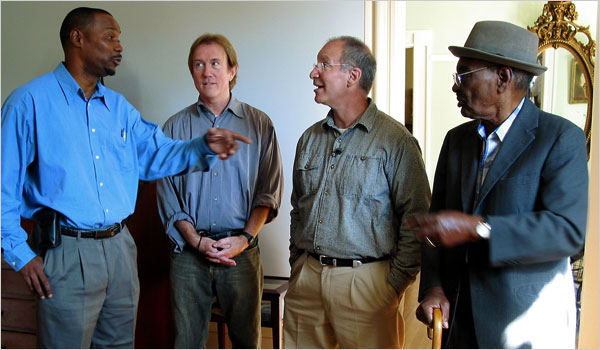|
Reviews of Recent Independent, Foreign, & Documentary Films in Theaters and DVD/Home Video

MOVING MIDWAY
Moving Midway deftly interweaves different interpretations of the antebellum South as if it were Rashomon. One is through the architecture, as represented by the plantation house of Midway, just outside Raleigh, North Carolina. Another is the South of family memories that are handed down as oral history, divided between black and white. Then there is the image of the region that has evolved through over a 150 years of popular culture that has swamped the facts. Subtitled A Southern Plantation in Transit, the genesis of the film came when debut director Godfrey Cheshire’s cousin announced at the family Christmas dinner “So we’re going to pick her up and go.” Moving a 200-year-old manor out of the way of bustling suburbia (for a mall called “The Shoppes at Midway Plantation”) is fascinating enough to watch throughout the documentary, which climaxes as the distinguished mansion moves miles away to a more protected site. Any fan of This Old House and other renovation shows will especially enjoy the perspective from the camera inside the house during the feat. But will all its ghosts come with it? As a New York-based film critic, Cheshire sees more than the nuts and bolts of his mother’s ancestral home. He extensively surveys where our images of the Southern plantation come from, which are intertwined with the country’s fascination and complications with race, sex, and wealth. Through a lot of clips and photographs, he reviews the impact of minstrel shows that played on Americans’ longing for a pastoral past, and examines other milestones—Uncle Tom’s Cabin, from book to silent film and TV movie, and The Klansman, from book to its adaptation as D.W. Griffiths’ The Birth of A Nation, which simultaneously revived the Klan in imitation and galvanized the NAACP in protest. The country’s reconstructed memories are then particularized through Cheshire’s family, especially in wary interviews. Midway has long been dominated by matriarchs, who are said to still haunt the house, from Mary Hinton, who lived there during the Civil War and ran the plantation for 40 years after her husband died, and her daughter Mimi Hinton, who lived there her entire long life and gave the filmmaker a fanciful genealogy and family history, which emphasized an aristocratic past and masters who were “kind” to their slaves. They could have been the template for William Faulkner’s description, in Requiem for a Nun, for “The undefeated undefeatable women, vulnerable only to death, resisted, endured…unsurrendered, irreconcilable who even after another thirty-five years would still get up and stalk out of picture houses showing Gone With the Wind.” Where Faulkner saw these upholders of the myth rejecting the film for its admission that the glorious cause was lost, Cheshire perceives its glorification, with Hollywood’s creation continuing to resonate. Then not only did the Roots TV mini-series, also shown in clips, make “white Americans feel guilty about slavery” and “shattered the plantation myth,” according to Cheshire, it had an impact on the direction of this film. Spurred on by the series, African Americans began researching their families and descendants of slaves from particular plantations. In the process of tracking down the African-American man who once came by Midway doing such research, Cheshire coincidentally finds a distant relative who can substantively provide a black point of view, NYU historian Robert Hinton, who helps him confirm how their family trees intersected. Together they figure out who the visitor was, which leads them, just as serendipitously, to yet another elderly witness and more background on Midway. Unfortunately, the level of historical research and documentation that Henry Louis Gates, Jr. amassed for his African American Lives PBS series is not available to this small independent production, so the folksy, and less accurate, family and Hollywood memories leave more of an impression than the real story recounted by Dr. Hinton and other academics. That the
talking-head intellectuals are upstaged in this film by the earthy
contractors and hands-on experts in house moving, or that tours of newly
saved slave cemeteries can’t quite compete for attention with Civil War
reenactments, supports Cheshire’s theme of people preferring flashier
myths. But as the white director and the black historian compare their
parallel childhoods in segregated Raleigh, and Cheshire is introduced to the African-American branch of his family, he very
effectively makes the case for how people can go beyond manufactured
myths to explore their commonalities on a person-to-person basis,
outside the movie theater. Nora Lee
Mandel
|

